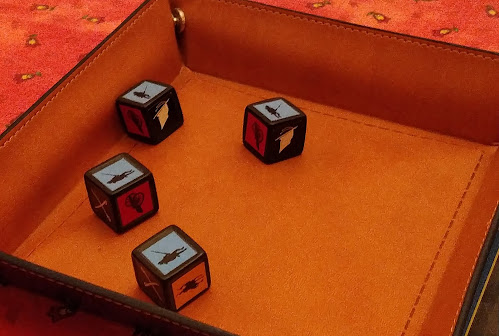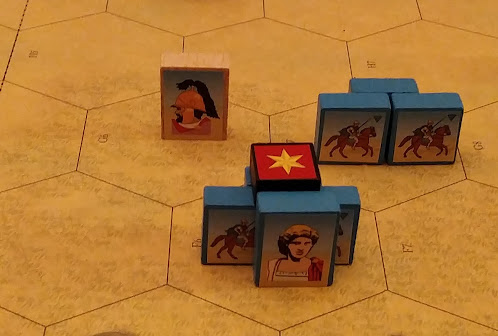After revisiting
the Peninsula with Commands and Colors: Napoleonics (GMT Games, 2010), we
returned to the first game I picked for by personal 6x6 challenge at the
beginning of the year (and this blog), Napoleon 1806 (Shakos, 2017). T
and I first played this back in January, twice, a couple of weeks apart. The
first game we dived in for the full game, but we made so many mistakes that I’m
considering our second game (from mid-February; mistakes were made here as
well, but not so many) as game number one of six.
%20-%20early%20first%20turn.jpg)
A couple of activations into the first turn.
Since it’s
been so long, I set up the three-turn introductory game and used the Rules for
the Conscript (kind of the basic game; most of the meat, but not as much
gravy). I’m happy with the way this one went, but I think I’d like to stick
with the Conscript rules for one more week to reinforce our understanding of
the game before moving on to the Rules for the Grognard* (the advanced rules)
for games 4-6.
T took the French (no surprise) and I played the Prussians.
The game s played out on a point-to-point map, which is beautifully rendered to
look like a field map of the region, with roads, river-crossings, forested
paths and significant towns and cities marked out in calligraphic font. It
really is a thing of beauty and a joy to play on.
It’s
been a while so I’ll take a moment to recap the details of the game. The pieces
represent the Generals and marshals commanding their respective columns. These
pieces are blocks with a French or Prussian eagle on one side, and the other
offering a tiny portrait and name of the commander and any extra information
conveyed in little symbols. Cards drive all the functions of the game; initiative,
movement and combat, and at the beginning of each turn three cards are drawn into
the player’s hand to offer small bonuses in combat, or to play for
reinforcements to individual columns. The strength and disposition of the
columns are recorded dynamically on shielded boards, with cubes representing each
unit’s infantry and cavalry strength, and orange cylinders marking accrued
exhaustion. Exhaustion plays a crucial role in the unfolding action of the
game.
In both
the introductory and full scenarios, the goal of the French player is to
control four target cities, Bamburg (which they hold at the start of the game),
Erfurt, Lille and Leipzig (for a sudden death victory). Each side also gains
points for hits against enemy units. The Victory Point Track runs from 0-20.
Twenty points for the French is another sudden death victory (however
unlikely); if the Russians can shift the needle to zero, it marks a sudden death
victory over the French.
Combat
occurs between combatant units occupying the same space, and relies on the
drawing of cards to establish the results of the altercation. Each unit will
draw a set number of cards, usually two. If the attacker instigates combat on
arrival – as mart of a move activation – they draw one less card. If the defender
is in a citadel (target city) or in a forested area (designated by a green location
square) they draw an extra card. The cards are revealed simultaneously, and the
damage is added up. This can be hits (loss of unit strength), accrued exhaustion,
or a combination of both. If the damage is even for both sides, the battle
ceases and both sides stay in the contested space. If one side has an advantage
in hits applied over the other, the loser has to retreat a number of points
corresponding to the differentiation (in a 4-2 result, the loser would withdraw
two places).
The introductory
game is only three turns long, beginning turn 5 and completing at the end of
turn 7. As the Prussians, I set out from the start to play a defensive game. I
moved nearly all of my units to the target cities; this is harder than it sounds.
Nearly all of them begin in roughly the centre of the board. Each time you
activate a unit, you declare the unit or units to be activated and draw a card.
The card will tell you how many points you can spend activating that unit. Movement
translates to one point spent to move from one location to an adjacent location
on the map. If you move two or more units together, you spend a point for each
unit over the first, then you can move the stack with whatever is left. Sometimes
you won’t be able to move at all, say if you declare three units together, but
draw a two-point card. They sit there and they’re done for the turn. This is a really
interesting break on what is really a game of manoeuvre, and something I’ll
explore in more depth in a later post.
T was
hampered in his initial movement by another neat rule involving movement. When
a unit runs into another unit in their army, they must stop; there’s no passing
or through-movement in Napoleon 1806. The French columns are a little more
scattered at the opening of the introductory scenario. Pulling a five-point
card to activate Soult is great until you realise he can only move two or three
places before he runs into Lannes or Ney. T lost some ground this way early in
the game, but it won’t be a mistake he’ll make next time.
I used
a couple of lower-strength units as road blocks to hinder T’s movement toward
the target cities. This was less effectual as T would meet them with his own
columns in tandem, and even with an extra card for defence, these poor Prussian
militia were no match for the onslaught of French Regulars. In the shorter game,
though, they did indeed slow T’s progress; though he held the bridge or the forest
pass, no other units could get through the choke-point to take advantage of the
newly “opened” passage until the combative units’ next activation.

Erfurt seized, Louis and Blücher routed.
T took
several points in damage to my units and the taking of Erfurt in the second
turn (turn 6 on the turn track), though he didn’t have the cavalry superiority
to harass my retreating columns, but couldn’t get his heavy-hitting columns up
quickly enough to offer a true challenge to Lille and Leipzig. If he'd managed to move Bernadotte and Devout up sooner, and was able to bring Murat up to screen his advance from my spoilers, the outcome would certainly been in question.
Overall,
Prussia was victorious but only due to France not meeting its objectives, especially
being so hampered in their movement at the beginning. As the Prussians, it wasn’t
a very satisfying victory, but in the end, it was really a refamiliarization game,
so neither of us were taking it so seriously. Next time, the gloves will come
off.
We have
four more plays-through to met my required six games, which will give us a good
opportunity to tease out the system’s nuances. Armed with just what we each
learnt so far, the next outing should be quite interesting.
.jpg) |
| French and Prussian column dispositions at game's end. |
* Interesting
aside: most of you reading a wargaming blog will probably know this already,
but the term Grognard (pronounced Grr-Urn-Yard – with a very soft
“d” (and an Inspector Clouseau accent)) is a term that became popular during the
early campaigns of Napoleon. Le Petit Caporal created la Vieille
Garde (Old Guard) from soldiers who had served in the Imperial Guard, and were
under the age of 35 but had served in at least three campaigns (though many had
served in fifteen or more). It was thought that the soldiers of the Old Guard
had earned their place and stature through devoted service, and so they were given
some latitude not afforded to the rank and file of Napoleon’s army. They were allowed
to grow their moustaches and sideburns in decorous fashion (and many tried to
out-do each other in this), and, while fiercely loyal to a man to their leader,
they had a reputation for complaining about everything; their rations, their
billets, long marches, lack of action, and so on. Within the Grand Armée
they were known as le grognards (the grumblers). One source suggests the
term was given to them by Napoleon himself. The soldiers wore this epithet with
pride, and further complaints.


.jpg)
.jpg)
.jpg)




.jpg)
(2).jpg)
.jpg)


.jpg)






.jpg)


.jpg)




.jpg)


(2).jpg)




